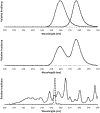Evaluating UV-C LED disinfection performance and investigating potential dual-wavelength synergy
- PMID: 27889622
- PMCID: PMC6145099
- DOI: 10.1016/j.watres.2016.11.024
Evaluating UV-C LED disinfection performance and investigating potential dual-wavelength synergy
Abstract
A dual-wavelength UV-C LED unit, emitting at peaks of 260 nm, 280 nm, and the combination of 260|280 nm together was evaluated for its inactivation efficacy and energy efficiency at disinfecting Escherichia coli, MS2 coliphage, human adenovirus type 2 (HAdV2), and Bacillus pumilus spores, compared to conventional low-pressure and medium-pressure UV mercury vapor lamps. The dual-wavelength unit was also used to measure potential synergistic effects of multiple wavelengths on bacterial and viral inactivation and DNA and RNA damage. All five UV sources demonstrated similar inactivation of E. coli. For MS2, the 260 nm LED was most effective. For HAdV2 and B. pumilus, the MP UV lamp was most effective. When measuring electrical energy per order of reduction, the LP UV lamp was most efficient for inactivating E. coli and MS2; the LP UV and MP UV mercury lamps were equally efficient for HAdV2 and B. pumilus spores. Among the UV-C LEDs, there was no statistical difference in electrical efficiency for inactivating MS2, HAdV2, and B. pumilus spores. The 260 nm and 260|280 nm LEDs had a statistical energy advantage for E. coli inactivation. For UV-C LEDs to match the electrical efficiency per order of log reduction of conventional LP UV sources, they must reach efficiencies of 25-39% or be improved on by smart reactor design. No dual wavelength synergies were detected for bacterial and viral inactivation nor for DNA and RNA damage.
Keywords: Bacillus pumilus spores; Combined wavelengths; Electrical energy per order; Human adenovirus type 2; Nucleic acid damage.
Copyright © 2016 Elsevier Ltd. All rights reserved.
Figures





Similar articles
-
Evaluation of disinfection efficacy of single UV-C, and UV-A followed by UV-C LED irradiation on Escherichia coli, B. spizizenii and MS2 bacteriophage, in water.Sci Total Environ. 2023 Feb 10;859(Pt 1):160256. doi: 10.1016/j.scitotenv.2022.160256. Epub 2022 Nov 17. Sci Total Environ. 2023. PMID: 36402311
-
Synergy of MS2 disinfection by sequential exposure to tailored UV wavelengths.Water Res. 2018 Oct 15;143:292-300. doi: 10.1016/j.watres.2018.06.017. Epub 2018 Jun 18. Water Res. 2018. PMID: 29986239
-
Inactivation efficacy and mechanisms of wavelength-specific UV sources for various strains of Legionella pneumophila serogroup 1.Sci Total Environ. 2024 Jan 10;907:167781. doi: 10.1016/j.scitotenv.2023.167781. Epub 2023 Oct 14. Sci Total Environ. 2024. PMID: 37844643 Free PMC article.
-
Evaluation survey of microbial disinfection methods in UV-LED water treatment systems.Sci Total Environ. 2019 Apr 1;659:1415-1427. doi: 10.1016/j.scitotenv.2018.12.344. Epub 2018 Dec 24. Sci Total Environ. 2019. PMID: 31096352 Review.
-
Considerations for determining the performance of ultraviolet light emitting diode fluid disinfection systems.Water Environ Res. 2023 Nov;95(11):e10947. doi: 10.1002/wer.10947. Water Environ Res. 2023. PMID: 38014702 Review.
Cited by
-
Light-based technologies for management of COVID-19 pandemic crisis.J Photochem Photobiol B. 2020 Nov;212:111999. doi: 10.1016/j.jphotobiol.2020.111999. Epub 2020 Aug 19. J Photochem Photobiol B. 2020. PMID: 32855026 Free PMC article. Review.
-
Roles and Knowledge Gaps of Point-of-Use Technologies for Mitigating Health Risks from Disinfection Byproducts in Tap Water: A Critical Review.Water Res. 2021 Jul 15;200:117265. doi: 10.1016/j.watres.2021.117265. Epub 2021 May 18. Water Res. 2021. PMID: 34091221 Free PMC article. Review.
-
Simultaneous Irradiation with UV-A, -B, and -C Lights Promotes Effective Decontamination of Planktonic and Sessile Bacteria: A Pilot Study.Int J Mol Sci. 2023 Aug 18;24(16):12951. doi: 10.3390/ijms241612951. Int J Mol Sci. 2023. PMID: 37629131 Free PMC article.
-
Application of a novel, continuous-feeding ultraviolet light emitting diode (UV-LED) system to disinfect domestic wastewater for discharge or agricultural reuse.Water Res. 2019 Apr 15;153:53-62. doi: 10.1016/j.watres.2019.01.006. Epub 2019 Jan 16. Water Res. 2019. PMID: 30690218 Free PMC article.
-
Improved disinfection performance for 280 nm LEDs over 254 nm low-pressure UV lamps in community wastewater.Sci Rep. 2023 May 10;13(1):7576. doi: 10.1038/s41598-023-34633-7. Sci Rep. 2023. PMID: 37165026 Free PMC article.
References
-
- Aitken A, Learmonth MP, 2001. Protein Determination by UV Absorption in Walker. J.M. The Protein Protocols Handbook Third Edition. Springer, pp. 3e6. APHA (American Public Health Association), AWWA (American Water Works Association), WEF (Water Environment Federation), 2012. Standard Methods for the Examination of Water and Wastewater, 22nd ed. American Public Health Association, Washington, DC.
-
- Autin O, Romelot C, Rust L, Hart J, Jarvis P, MacAdam J, Parsons SA, Jefferson B, 2013. Evaluation of a UV-light emitting diodes unit for the removal of micropollutants in water for low energy advanced oxidation processes. Chemosphere 92 (6), 745–751. - PubMed
-
- Beck SE, Rodriguez RA, Linden KG, Hargy TM, Larason TC, Wright HB, 2014. Wavelength dependent UV inactivation and DNA damage of adenovirus as measured by cell culture infectivity and long range quantitative PCR. Environ. Sci. Technol 48, 591–598. - PubMed
-
- Beck SE, Wright H, Hargy T, Larason TC, Linden KG, 2015. Action spectra for validation of pathogen disinfection in medium-pressure ultraviolet (UV) systems. Water. Res 70, 27–37. - PubMed
MeSH terms
Grants and funding
LinkOut - more resources
Full Text Sources
Other Literature Sources
Medical
Molecular Biology Databases

